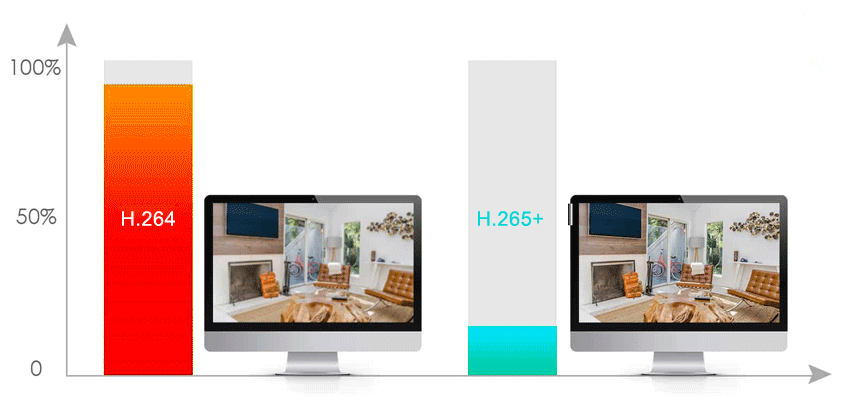Are you tired of experiencing freezing video feeds or running out of storage space for your IP camera system? With H.265 IP cameras, you can now stream high-quality videos without compromising bandwidth or disabling the performance of your other online devices. These cameras compress footage into smaller file sizes, enabling you to store more footage.
But what are H.265 IP cameras? How do they preserve bandwidth usage and minimize storage consumption? What sets them apart from H.264 IP cameras, and where can you find the best H.265 security cameras on the market?
Read this post for answers to all these questions about H.265 IP cameras.
Contents
What Are H.265 IP Cameras
H.265 IP cameras are advanced surveillance cameras that utilize H.265 High-Efficiency Video Coding (HEVC) to encode video data. H.265 is an advanced video compression standard that encodes video twice as efficiently as its predecessor, Advanced Video Coding (AVC), also known as H.264.

Compared to H.264 security cameras, H.265 video cameras can double the data compression ratio while retaining the same level of video quality. This means H.265 surveillance cameras can reduce bandwidth utilization and storage consumption by approximately 50% while still ensuring excellent image quality across various video applications.
H.265 security cameras typically feature 4K/8MP high-resolution capabilities, and some models even support ultra-high definition resolutions up to 8192 × 4320 pixels. While 1080p and 1440p content remain popular, H.264 security cameras are becoming increasingly outdated compared to the enhanced features and greater efficiency of H.265 security cameras.
How Do H.265 Security Cameras Work
H.265, also known as HEVC (High-Efficiency Video Coding), is the successor to the H.264 video compression standard, aimed at improving the efficiency of video compression for high-quality video streaming.
H.265 IP cameras capture raw footage according to the user’s recording mode settings and encode the videos in H.265 compression after processing the images. H.265 improves upon H.264, which only allows a maximum of 16×16 pixel macroblocks to process information, by permitting larger block sizes of up to 64×64 pixel Coding Tree Units (CTUs), resulting in greater encoding efficiency – especially for larger frame sizes like 4K resolution. Other features like improved deblocking filter and motion vector prediction also contribute to the efficiency of H.265 IP cameras.
Put simply, H.265 CCTV cameras can encode videos at the lowest possible bitrate, while retaining a certain level of video quality, resulting in optimal compression and bandwidth utilization.
Why Should You Choose H.265 Cameras
The advent of H.265 IP cameras has revolutionized the security industry, providing new possibilities and convenience. The following advantages of H.265 CCTV cameras are clear reasons why you should consider using them:
1. Reduced Bandwidth Usage and Storage
Consumption H.265 IP cameras feature a lower bitrate, thanks to their advanced video compression, compared to H.264 and MJPEG security cameras in the same resolution. This reduction in bitrate translates to less required bandwidth and storage capacity, cutting storage requirements up to 50% or more.
2. Improve Live Feed & Remote Viewing Quality
H.265 IP cameras reduce the required bandwidth while maintaining image quality, ensuring a smoother live feed and remote viewing experience on smart devices even with a less powerful network system. H.265 security cameras can even stream 4K videos over common networks without laggy or frozen images.
3. Better Image Quality
Larger blocks of H.265 IP cameras result in more accurate information when compressing 4K videos, surpassing the maximum block size of 16×16 in H.264. This efficient video compression coding ensures smooth footage streaming without any frozen or delayed images.
4. Longer Recording Time
H.265 IP cameras reduce storage usage by 50-60%. This translates to smaller file sizes for recorded footage, allowing longer recording time before overwriting. Using SD cards or H.265 NVR, the H.265 security camera can reduce the additional cost of storing data, such as paying for the cloud or external hard disk drive.
5. Multiple Streaming Options
H.265 IP cameras provide various resolution streams to choose from, ranging up to 8K ultra HD high resolution, catering to individual networks, internet speeds, and storage spaces.
H.265 IP Cameras vs H.264 IP Cameras
After conducting rigorous testing on H.265 IP cameras and H.264 cameras, we have concluded their main differences from the following aspects:
1. Bandwidth Consumption
H.265 IP cameras possess higher H.265 compression ratios compared with H.264 cameras, reducing network bandwidth consumption by nearly 50% in the same level of video quality. The table below provides an overview of recommended bandwidth for H.265 and H.264 security cameras in different resolutions.
| Resolution | Minimum Upload Speed | |
| H.265 IP Cameras | H.264 IP Cameras | |
| 720p | 2 mbps | 5 mbps |
| 1080p | 4 mbps | 8 mbps |
| 1440p | 8 mbps | 16 mbps |
| 4K | 15 mbps | 32 mbps |
Note: Actual results may vary with your environment and other factors.
2. Storage Usage
As the bitrate is proportional to the required storage usage, H.265 IP cameras with lower bitrate compress videos in almost half the file size compared to H.264 cameras, while retaining the original video quality.
3. Recording Time Length
H.265 CCTV cameras have lower bitrates than H.264 IP cameras. Thus, with the same storage space, H.265 IP security cameras can allow for longer recording times before the older files are automatically overwritten. (Learn more about how long security cameras can record.)
4. Video Quality
Utilizing the CTUs (Coding Tree Units), H.265 cameras incorporate larger pixel blocks than H.264 IP cameras. These larger blocks improve compression efficiency for larger frame sizes, making H.265 IP cameras more suitable for producing higher resolution images and videos with less bandwidth usage and storage consumption, such as 4K and 8K ultra HD footage.
Where Can You Place H.265 Surveillance Cameras
H.265 IP cameras are incredibly versatile and suitable for a wide range of applications, both indoors and outdoors, in homes and businesses. You can place H.265 security cameras in multiple locations, including your front door, back door, garden, garage, shop, construction sites, schools, hospitals, bars, and more.
H.265 CCTV cameras are especially ideal for delivering ultra-high definition videos with highly efficient video compression coding, like 4K and 8K resolution. Some reputable security camera brands are already providing or planning to offer 4K H.265 cameras for recording the clearest possible videos with less network consumption and storage usage.
If you need to monitor large areas while minimizing bandwidth and storage usage, a 4K H.265 security camera system could be the perfect solution. It includes an H.265 NVR for storing long-term video recordings, enabling you to keep an eye on critical areas while saving on storage costs.
Should You Buy H.265 Cameras or Not
It depends on your specific needs. While H.265 CCTV security cameras are relatively new, they are becoming more accessible. However, their higher price point may be a factor to consider.
Moreover, H.265 IP cameras are designed primarily to deliver ultra-high definition videos, such as 4K and 8MP, making them ideal for monitoring large areas that require greater detail. Thus, if you need to cover relatively smaller areas and have a tight budget, an H.264 security camera would be enough to produce 5MP/1440p/1080p videos with necessary details.
Conclusion
H.265 IP cameras offering high-quality video streaming without the bandwidth and storage issues of older cameras. With their advanced compression technology, they can reduce storage needs by up to 50%. While they may be pricier, their benefits, like better live feed quality and longer recording times, make them a smart choice for those needing top-notch surveillance.
